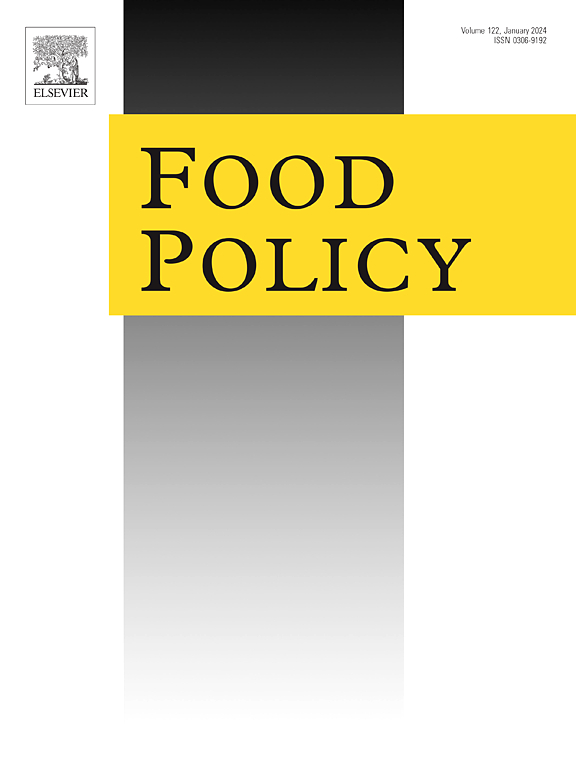A comparison of the effects of local and EAT-Lancet dietary recommendations on selected economic and environmental outcomes in India
IF 6
1区 经济学
Q1 AGRICULTURAL ECONOMICS & POLICY
引用次数: 0
Abstract
The global discourse is nearly unanimous that dietary transitions are crucial to achieve sustainability goals. In this context, healthy dietary recommendations offer demand-side solutions towards minimizing environmental impacts from food production. However, these guidelines have also faced some criticism for their blanket approach and limited consideration of regional preferences. Using a validated food-economy-environment integrated modelling framework, we compare between two types of healthy diets − the globally recommended EAT-Lancet diets and Indian government’s National Institute of Nutrition (NIN) local diets − by examining their impacts on agricultural production, agricultural commodity prices, food expenditures, trade impacts, Greenhouse gas (GHG) emissions and water withdrawals. Our results suggest that the adoption of regional recommendations (NIN diets) lead to better outcomes for select economic and environmental indicators. When India shifts to NIN diet, its domestic demand for cereal crops decreases, leading to a 36 % reduction in cereal crop production by 2050 and change in demand for sugars and animal-sourced foods (ASFs). This has the potential to reduce commodity prices of food by upto 24 % by 2050. A shift to the NIN diet in India reduces methane (CH4) emissions by 36 % and N2O by 35 % compared to business-as-usual, performing better than the EAT-Lancet diet, which reduces CH4 emissions by 13 %. Water withdrawals reduce almost by the same value under both the dietary scenarios primarily due to lesser dependence on cereal crops and livestock products. These findings remain consistent in our sensitivity analysis, with varying global trade scenarios, offering greater benefits of food systems transformation through liberal trade policies. Our analysis underscores the pivotal role of regional inclusivity in global assessments, enhancing our comprehension of how food systems can be reimagined to align with both food security and environmental sustainability.
比较印度当地和EAT-Lancet饮食建议对选定经济和环境结果的影响
全球几乎一致认为,饮食转变对实现可持续发展目标至关重要。在这方面,健康饮食建议为尽量减少粮食生产对环境的影响提供了需求方解决方案。然而,这些指导方针也因其笼统的做法和对区域偏好的有限考虑而面临一些批评。我们使用经过验证的粮食经济环境综合建模框架,通过考察两种健康饮食对农业生产、农产品价格、食品支出、贸易影响、温室气体(GHG)排放和取水的影响,对两种类型的健康饮食——全球推荐的EAT-Lancet饮食和印度政府国家营养研究所(NIN)的当地饮食进行了比较。我们的研究结果表明,采用区域建议(NIN饮食)可以在选定的经济和环境指标上取得更好的结果。当印度转向NIN饮食时,其对谷物作物的国内需求减少,导致到2050年谷物作物产量减少36%,对糖和动物源食品(asf)的需求发生变化。到2050年,这有可能使粮食商品价格降低24%。与往常相比,印度向NIN饮食的转变减少了36%的甲烷(CH4)排放和35%的N2O排放,比EAT-Lancet饮食的效果更好,后者减少了13%的CH4排放。在这两种饮食方案下,取水量减少的幅度几乎相同,主要原因是对谷类作物和畜产品的依赖程度降低。这些发现在我们的敏感性分析中保持一致,在不同的全球贸易情景中,通过自由贸易政策实现粮食系统转型带来了更大的好处。我们的分析强调了区域包容性在全球评估中的关键作用,增强了我们对如何重新构想粮食系统以与粮食安全和环境可持续性保持一致的理解。
本文章由计算机程序翻译,如有差异,请以英文原文为准。
求助全文
约1分钟内获得全文
求助全文
来源期刊

Food Policy
管理科学-农业经济与政策
CiteScore
11.40
自引率
4.60%
发文量
128
审稿时长
62 days
期刊介绍:
Food Policy is a multidisciplinary journal publishing original research and novel evidence on issues in the formulation, implementation, and evaluation of policies for the food sector in developing, transition, and advanced economies.
Our main focus is on the economic and social aspect of food policy, and we prioritize empirical studies informing international food policy debates. Provided that articles make a clear and explicit contribution to food policy debates of international interest, we consider papers from any of the social sciences. Papers from other disciplines (e.g., law) will be considered only if they provide a key policy contribution, and are written in a style which is accessible to a social science readership.
 求助内容:
求助内容: 应助结果提醒方式:
应助结果提醒方式:


